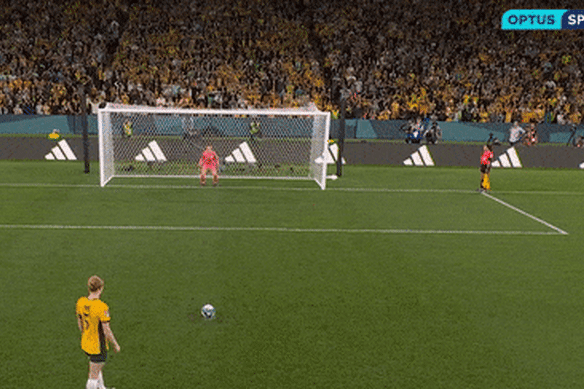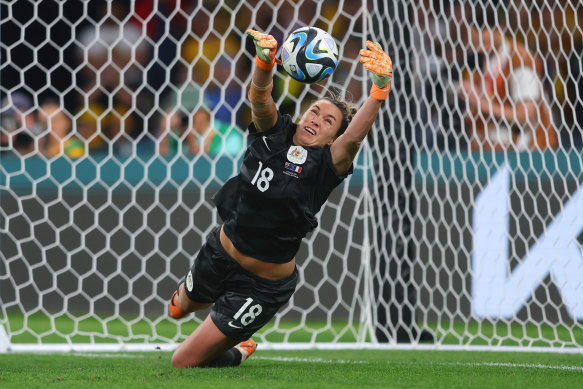Nausea, tension, mind games and glory: How a penalty shootout works
If you watched the penalty shootout that decided the Matildas’ quarter-final against France, you will be familiar with the following impulses and emotions.
Unspeakable tension. The feeling of wanting to vomit. Short-lived relief. More nausea. Disbelief that any human could execute a skill under such pressure. Elation. So, you know that a penalty shootout is one of the most dramatic situations in sport, and that the stakes in the knockout phase of a World Cup could not be higher.
But how does a penalty shootout work?
To prepare for the possibility of another shootout in Wednesday night’s semi-final, we take a look at the rules.
When does a penalty shootout happen?
A penalty shootout will decide a game in a knockout phase, where there must be a winner to advance, after extra time if the game is still tied.
After regulation play (90 minutes) plus any additional time is played, if the game doesn’t have a winner, two 15-minute halves of extra time will be played from either end.
Penalty shootouts were introduced in 1970 knockout tournament play to determine a winner if games were still tied after extra time (before this, they used to toss a coin; talk about cruel way to bow out).
How does it work?
The shootout consists of a minimum of five alternate penalty kicks taken by each of the two teams from the penalty spot, which is nine metres from the goal line.
The team with the most penalties scored after the first five takes wins the shootout. If the score is tied at the end of the 10 shots, sudden death kicks in. Both teams take a kick until a winner is found.

Cortnee Vine sends the Brisbane crowd into raptures.Credit: Optus Sport
Teams can only use players who are on the pitch at the end of match play and a different player must be used for each kick.
A player involved in the first five kicks cannot be reused in the sudden-death situation until all other players on their side, including the goalkeeper, have taken their turn. This means Australia can’t use Sam Kerr or Mary Fowler twice until everyone else on the pitch has taken their turn.
Goalkeepers can go at any time. For example, Mackenzie Arnold was Australia’s fifth penalty taker against France.
Against France, everyone for the Matildas on the park took a shot except Alanna Kennedy, the 11th taker. If Australia (heaven forbid) got to the 12th shot, Caitlin Foord, Australia’s first taker, could have gone again.
The captains of the two teams will meet with the referee before the shootout and a coin toss will decide who goes first.
What are the rules?
If a goalkeeper is sent off during the shootout due to injury, another player who finished the game (on the pitch) must replace them.
The goalkeeper needs to have at least one foot touching the goal line, or behind it, the moment of impact (when the penalty taker kicks the ball). If the goalie comes off their line, the penalty will be retaken. We saw this on Saturday night when France’s Kenza Dali’s spot kick had to be retaken because Mackenzie Arnold came off her line (she saved both shots).

Mackenzie Arnold saves the ninth penalty from Kenza Dali of France in the shootout.Credit: FIFA/Getty Images
Unlike, match-play penalty kicks, the kicker cannot score off the rebound. Once it’s left their boot, it’s either missed, saved or won.
Goalkeepers try to read the kicker’s motion pattern. While kickers may attempt to delay their shot to determine which way the keeper will dive, it’s for this reason that kickers are not allowed to stop mid run when taking their shot.
What tactics are used?
Professional sides train for penalties and there are plenty of tactics in play.
The first is the players used. Throughout this tournament, we’ve seen players subbed on late in extra time because they’re good at taking penalties, such as the USA’s Kristie Mewis, who was brought in with two minutes remaining against Sweden before it went to penalties.
In the round of 16, England brought in Chloe Kelly at the 87th minute (to replace Lauren James who received a red card) against Nigeria. Kelly not only won the game for the Lionesses during penalties but set a record for the fastest shot of the tournament at 110.79 km/h, which also beat any strike of English Premier League and Women’s Super League last season.
As we saw in the France game, this player change can also include the goalkeeper. France manager Herve Renard subbed his starting goalkeeper Pauline Peyraud-Magnin off and put on Solene Durand preparing for the penalty shootout.
Another tactic many teams use is putting their best player fifth, as it’s often the decisive kick (if the opposition miss, teams can win 5-4) meaning there’s added pressure and mental strength needed for the job. For Australia against France, this was Arnold, who is known to sink penalties during training but missed last Saturday, sending the shootout into sudden death.
Each player will also have their own internal strategy. Do they aim it to the left or right, bottom corner or higher up? Do they go with their usual technique or shake things up to try and throw the opposition goalkeeper off guard?
In 2019, Kerr changed her usual routine against Norway and sliced the ball wide. This time against France, she stuck to her usual routine and found the net.
News, results and expert analysis from the weekend of sport sent every Monday. Sign up for our Sport newsletter.